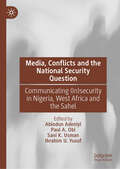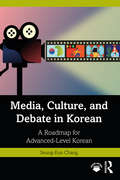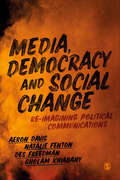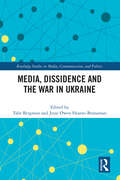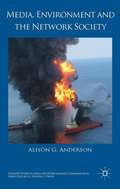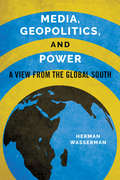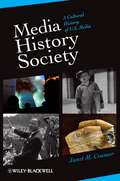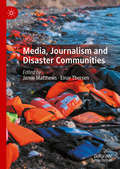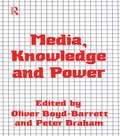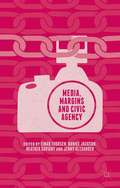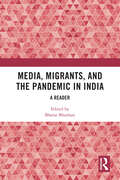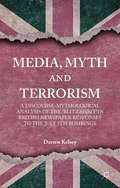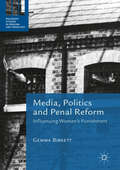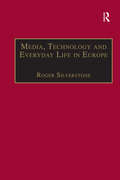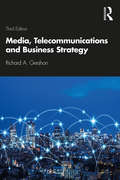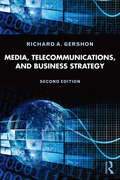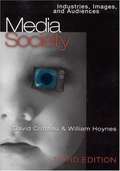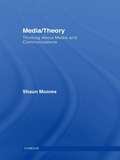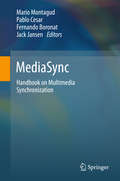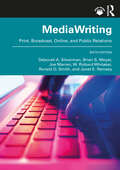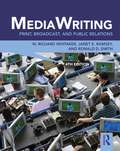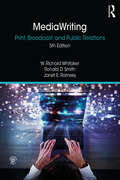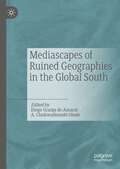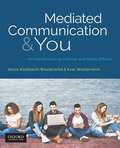- Table View
- List View
Media, Conflicts and the National Security Question: Communicating (In)security in Nigeria, West Africa and the Sahel
by Abiodun Adeniyi Paul A. Obi Sani K. Usman Ibrahim U. YusufThis book explores how the media, and journalism in a cross-disciplinary sense, has treated conflicts in Nigeria, West Africa and the Sahel. Contributors connect theoretical foundations with practical experiences in the study of media, conflicts and national security, seeking to unravel the mediated and communication logic(s) in news coverage and analyse the media's role in pre-conflict, in-conflict and post-conflict discourses. The work maps out the impact of mediated narratives on security, risk, terrorism, banditry and general society, relying on local, on-the-spot and ontological cultural experiences in Africa, especially Nigeria, Ghana, Sierra Leone and other parts of West Africa.
Media, Culture, and Debate in Korean 미디어, 문화, 토론을 통한 고급 한국어 수업: A Roadmap for Advanced-Level Korean
by Seung-Eun ChangMedia, Culture, and Debate in Korean provides a roadmap for an advanced-level Korean course centered around media and culture and includes access to an archive of virtual media resources such as film, documentary, shows, newspaper, drama, music, and advertising. The book is designed to help students enhance their language skills and to deepen their knowledge and understanding of contemporary Korean society and culture through the analysis of authentic Korean media resources and debate. It addresses the cultural issues permeating Korean society that are rapidly transforming people’s perspectives, language, and lifestyle. These societal issues are discussed in the context of historical and psychological background, the struggle between tradition and changing values, positive and negative impact of the phenomenon, neologism, and potential solutions. This book can serve as a main textbook as well as a resource for an online class setting and can also be used in a traditional face-to-face class setting.
Media, Democracy and Social Change: Re-imagining Political Communications
by Des Freedman Aeron Davis Natalie Fenton Gholam KhiabanyWhen we are told so regularly that we live in a ‘post truth’ age and are surrounded by ‘fake news’, it can be tempting to think of politics as primarily mediated. Discussion and analysis of public affairs is preoccupied with the power and reach of platforms or the passion and rage of social media exchanges. As important as these issues may be, a focus on the communicative risks downgrading the political. Media, Democracy and Social Change puts politics back into political communications. It shows how within a digital media ecology, the wider context of neoliberal capitalism remains essential for understanding what political communications is, and can hope to be. Tackling broad themes of structural inequality, technological change, political realignment and social transformation, the book explores political communications as it relates to debates around the state, infrastructures, elites, populism, political parties, activism, the legacies of colonialism, and more. It is both an expert introduction to the field of political communications, and a critical intervention to help re-imagine what a democratic politics might mean in a digital age. It will be essential reading for students, researchers and activists. Aeron Davis, Natalie Fenton, Des Freedman and Gholam Khiabany all work at the Department of Media and Communication at Goldsmiths, University of London, where they teach together on the MA in Political Communications.
Media, Democracy and Social Change: Re-imagining Political Communications
by Des Freedman Aeron Davis Natalie Fenton Gholam KhiabanyWhen we are told so regularly that we live in a ‘post truth’ age and are surrounded by ‘fake news’, it can be tempting to think of politics as primarily mediated. Discussion and analysis of public affairs is preoccupied with the power and reach of platforms or the passion and rage of social media exchanges. As important as these issues may be, a focus on the communicative risks downgrading the political. Media, Democracy and Social Change puts politics back into political communications. It shows how within a digital media ecology, the wider context of neoliberal capitalism remains essential for understanding what political communications is, and can hope to be. Tackling broad themes of structural inequality, technological change, political realignment and social transformation, the book explores political communications as it relates to debates around the state, infrastructures, elites, populism, political parties, activism, the legacies of colonialism, and more. It is both an expert introduction to the field of political communications, and a critical intervention to help re-imagine what a democratic politics might mean in a digital age. It will be essential reading for students, researchers and activists. Aeron Davis, Natalie Fenton, Des Freedman and Gholam Khiabany all work at the Department of Media and Communication at Goldsmiths, University of London, where they teach together on the MA in Political Communications.
Media, Dissidence and the War in Ukraine (Routledge Studies in Media, Communication, and Politics)
by Tabe Bergman Hearns-Branaman, Jesse OwenThis volume examines the global media coverage of the armed conflict in Ukraine, focusing on the marginalization of dissident perspectives in the West and the information quality and diversity on social media.Along with presenting original, empirical studies on how mainstream media in countries as diverse as Israel, the Czech Republic, Ghana, and the Netherlands have covered the conflict between NATO and Russia since 2022, this book sheds light on the role of the state and the media in policing the boundaries of permissible thought on the conflict in the West, as well as in Russia and Ukraine. It also delves into the war’s representation on prominent social media platforms.Written by a diverse group of international researchers, this multifaceted volume offers new perspectives and insights on the reporting of the ongoing conflict. It will interest scholars of international communication and media, foreign policy and international politics, war and conflict, content analysis, and journalism.
Media, Environment and the Network Society
by Alison G. AndersonThe news media has become a key arena for staging environmental conflicts. Through a range of illuminating examples ranging from climate change to oil spills, Media, Environment and the Network Society provides a timely and far-reaching analysis of the media politics of contemporary environmental debates.
Media, Geopolitics, and Power: A View from the Global South (Geopolitics of Information)
by Herman WassermanThe end of apartheid brought South Africa into the global media environment. Outside companies invested in the nation's newspapers while South African conglomerates pursued lucrative tech ventures and communication markets around the world. Many observers viewed the rapid development of South African media as a roadmap from authoritarianism to global modernity. Herman Wasserman analyzes the debates surrounding South Africa's new media presence against the backdrop of rapidly changing geopolitics. His exploration reveals how South African disputes regarding access to, and representation in, the media reflect the domination and inequality in the global communication sphere. Optimists see post-apartheid media as providing a vital space that encourages exchanges of opinion in a young democracy. Critics argue the public sphere mirrors South Africa's past divisions and privileges the viewpoints of the elite. Wasserman delves into the ways these simplistic narratives obscure the country's internal tensions, conflicts, and paradoxes even as he charts the diverse nature of South African entry into the global arena.
Media, History, Society: A Cultural History Of U. S. Media
by Janet M. CramerMedia/History/Society offers a cultural history of media in the United States, shifting the lens of media history from media developments and evolution to a focus on changes in culture and society, emphasizing how media shaped and were shaped by these trends, policies, and cultural shifts. <p><p> Covers the topics that instructors want to teach <p> Provides a timely and relevant culturally determined perspective on media history in American society <p> Organized thematically rather than chronologically <p> Links history to contemporary issues, setting journalism into a broader historical context <p> Includes alternate table of contents, discussion questions, an instructor’s manual, and sample exams
Media, Journalism and Disaster Communities
by Einar Thorsen Jamie MatthewsThis book illuminates the concept of disaster communities through a series of international case studies. It offers an eclectic overview of how different forms of media and journalism contribute to our understanding of the lived experiences of communities at risk from, affected by, and recovering from disaster. This collection considers the different forms of media and journalism produced by and for communities and how they may recognise and speak to the different notions of community that emerge in disaster contexts – including vulnerabilities and consequences that arise from environmental destruction and geophysical hazards, the insecurity created by armed conflict and limitations on journalistic freedoms, and result from human (in)action and humanitarian crises.
Media, Knowledge and Power
by Oliver Boyd-Barrett Peter BrahamFirst Published in 1986. The readings reflect the current interest in the possible effects that such communications media may have upon children's studies and cognition and upon how children are likely to respond to education and educational media.
Media, Margins and Civic Agency
by Daniel Jackson Jenny Alexander Heather Savigny Einar ThorsenThis collection brings together new research on contemporary media, politics and power. It explores ways and means through which media can and do empower or dis-empower citizens at the margins that is, how they act as vehicles of, or obstacles to, civic agency and social change.
Media, Migrants and the Pandemic in India: A Reader
by Bharat BhushanThe national lockdown to contain the COVID-19 pandemic in India resulted in the loss of work and displacement of thousands of urban migrant workers. This book records the arduous journey home for many of these workers and analyses the grave effects the pandemic has had on jobs, livelihoods, and the health of urban migrant workers. A rich compilation of deep analytical articles by journalists, academics, lawyers, and social activists, this book explores various facets of the crisis as it unfolded. It examines the welfare policies of state and central governments and discusses the role of the judiciary and the public policy response to the unemployment, health risks, and mass migration of workers. It also offers readers a better understanding of the complexities of the migrant crisis, how it unfolded, and how it was addressed by the media. This timely and prescient book will be of great interest to the general reader as well as researchers and students of media studies, journalism, sociology, law, public policy, labour and economics, welfare economics, gender studies, and development studies.
Media, Myth and Terrorism
by Darren KelseyMedia, Myth and Terrorism provides a rigorous case study of Blitz mythology in British newspaper responses to the July 7th bombings. Considering how the press, politicians and members of the public were caught up in popular accounts of Britain's past, Kelsey explores the ideological battleground that took place in the weeks following the bombings as the myth of the Blitz was invoked. By providing conceptual discussions of myth, discourse, and ideology, Kelsey proposes a discourse-mythological framework designed for analysing discursive constructions of mythology. In doing so, this research considers multiple recontextualisations of the Blitz myth when popular memories of 1940 recurred in 2005. Kelsey encourages readers to understand the politics of remembering by showing how popular yet inaccurate stories from the past have a significant impact on our perceptions of the present. Heroism, trauma, economics, Royalty, rituals, human rights, foreign policy, immigration and multiculturalism are just some of the topics covered across a vast landscape of stories embracing a myth from the past in order to understand the present.
Media, Politics and Penal Reform
by Gemma BirkettThis book examines the nature of relations between penal reform campaigners, journalists and policymakers at the crime-media nexus. With a particular focus on women's penal policy, Birkett uncovers how reform strategies have augmented and developed under changing governments and the news media spotlight. While penal reformers have traditionally relied on the language of humanitarianism to influence the direction of policy, there remains an array of political and cultural sticking points. With a policy-focused orientation, this study provides a number of pragmatic and practical tips for those wishing to think more strategically about their ability to influence politicians, the media and the public. With unprecedented access to over thirty policy elites working around Westminster and Whitehall during the development of the Corston agenda (and beyond), this engaging and timely work exposes the triumphs and tribulations of such actors for the very first time.
Media, Technology and Everyday Life in Europe: From Information to Communication
by Roger SilverstoneThe importance of the daily experience of new information and communication technologies is highlighted by this timely volume. The book is based on work carried out in the European Media Technology and Everyday Life Network and is structured round a series of seven empirical case studies drawn from research within Europe. The application of this perspective draws attention not just to the significance of information and communication technologies for a mature understanding of the conduct of everyday life in contemporary Europe, but also for the significance of that understanding for the development of communication and information policy. The research makes a significant contribution to our understanding of the dynamics and evolution of a core dimension of European society as well as informing on-going and important debates on the nature of the relationship between the social and the technological in the information and communication arena.
Media, Telecommunications and Business Strategy
by Richard A. GershonAs the clear lines and historic boundaries that once separated broadcasting, cable, telephone and Internet communication dissolve, this comprehensive new edition examines the relationship and convergence patterns between industries by exploring the effects of digitalization in media and information technology. With today’s dynamic and rapidly evolving communication environment, media managers need to have a clear understanding of the different delivery platforms as well as critical management and planning strategies going forward. Advancements in new media and communication technology coupled with a rapidly changing global economy promise a new set of hybrid-media companies that will allow for the full integration of information and entertainment services and give new meaning to the term programming. This book provides a detailed look at seven key sectors of the media and telecommunications field as well as ongoing changes within the industry. The new edition includes updated research throughout including material on major business and technology changes as well as the importance of digital lifestyle reflected in E-commerce and developments in Over-the-Top Video-streaming services. Special attention is given to such areas as strategic planning, innovation, marketing, finance and leadership. Perfect for courses in media management and media industries, as well as professional managers, this book serves as an important reference guide during this transitional time.
Media, Telecommunications, and Business Strategy
by Richard A. GershonWith today’s dynamic and rapidly evolving environment, media managers must have a clear understanding of different delivery platforms, as well as a grasp of critical management, planning, and economic factors in order to stay current and move their organizations forward. Developed for students in telecommunications management, media management, and the business of media, this text helps future media professionals understand the relationship and convergence patterns between the broadcast, cable television, telephony, and Internet communication industries. The second edition includes updated research throughout , including material on major business and technology changes and the importance of digital lifestyle reflected in e-commerce and personalized media selection, such as Netflix and iTunes, and the growing importance of Facebook and social networking from a business perspective.
Media/Society: Industries, Images, and Audiences
by David Croteau William HoynesPresenting the new edition of their undergraduate-level textbook, Croteau (sociology and anthropology, Virginia Commonwealth U.) and Hoynes (sociology, Vassar College) discuss the social components of the mass media and highlight the tension between constraint and action. Their analysis is based on a social model that sees media as being part of multidimensional process of complex interaction between audiences, technology, medial message, and media industry, all operating within the wider context of the social world. Annotation c. Book News, Inc., Portland, OR (booknews.com)
Media/Theory: Thinking about Media and Communications
by Shaun MooresFrom an established author with a growing international profile in media studies, Media/Theory is an accessible yet challenging guide to ways of thinking about media and communications in modern life. Shaun Moores draws on ideas from a range of disciplines in the humanities and social sciences, and expertly connects the analysis of media and communications with key themes in contemporary social theory. Examining core issues of time and space, Moores also examines matters of interactions, signification and identity, and argues that media studies is bound up in the wider processes of the modern world and not just about studying the media. This book makes a distinctive contribution towards rethinking the shape and direction of media studies today, and for students at advanced undergraduate or postgraduate level.
MediaSync: Handbook On Multimedia Synchronization
by Mario Montagud Pablo Cesar Fernando Boronat Jack JansenThis book provides an approachable overview of the most recent advances in the fascinating field of media synchronization (mediasync), gathering contributions from the most representative and influential experts. Understanding the challenges of this field in the current multi-sensory, multi-device, and multi-protocol world is not an easy task. The book revisits the foundations of mediasync, including theoretical frameworks and models, highlights ongoing research efforts, like hybrid broadband broadcast (HBB) delivery and users’ perception modeling (i.e., Quality of Experience or QoE), and paves the way for the future (e.g., towards the deployment of multi-sensory and ultra-realistic experiences). Although many advances around mediasync have been devised and deployed, this area of research is getting renewed attention to overcome remaining challenges in the next-generation (heterogeneous and ubiquitous) media ecosystem. Given the significant advances in this research area, its current relevance and the multiple disciplines it involves, the availability of a reference book on mediasync becomes necessary. This book fills the gap in this context. In particular, it addresses key aspects and reviews the most relevant contributions within the mediasync research space, from different perspectives. Mediasync: Handbook on Multimedia Synchronization is the perfect companion for scholars and practitioners that want to acquire strong knowledge about this research area, and also approach the challenges behind ensuring the best mediated experiences, by providing the adequate synchronization between the media elements that constitute these experiences.
MediaWriting: Print, Broadcast, Online, and Public Relations
by Ronald D. Smith Janet E. Ramsey W. Richard Whitaker Deborah A. Silverman Brian S. Meyer Joe MarrenAccessible and engaging, this book is an invaluable resource for students planning to enter the dynamic and changing world of media writing.Drawing on a wealth of real-world examples and featuring helpful "How To" boxes throughout, MediaWriting explains the various styles of writing for print, broadcast, online, social media, public relations, and multimedia outlets.Expanded and updated throughout, this sixth edition features: A look at how journalists and PR practitioners use and write for social media platforms such as X and Facebook; Tips for better web writing, research, interviewing, and headline writing across multiple media platforms, including covering breaking news in the digital world; Coverage of public relations writing for digital media, publications, and other organizational media; Updates on current ethical issues faced by communicators; Information on spotting “fake news” and “deep fakes”; Strategies for integrating sound bites into broadcast scripts; New “It Happened to Me” anecdotes from the authors’ experiences as journalists and PR professionals; Updated discussion questions and writing exercises. Designed to meet the needs of students of digital, print, and broadcast media, public relations, or a wannabe jack-of-all trades in the online media environment, this reader-friendly primer will equip beginners with all the skills necessary to succeed in their chosen writing field.Online instructor and student support material is available for this book, including sample syllabi, quizzes and answer keys, chapter overviews, and links to further resources.
MediaWriting: Print, Broadcast, and Public Relations
by Ronald D. Smith Janet E. Ramsey W. Richard WhitakerMediaWriting is an introductory, hands-on textbook for students preparing to write in the current multimedia environment. Rather than just talk about the differences among the styles of print, broadcast, and public relations, MediaWriting sythensizes and integrates them, while weaving in basic principles of Internet writing and social media reporting. Complete with real-world examples, practical writing exercises, and tips and information for entering into the profession, MediaWriting continues to give students the tools they need to become a successful media writer. The new edition has been extensively rewritten to reflect the dynamic nature of the profession, paying significant attention to how the Internet and social media have become essential communication tools for print and broadcast journalists, and public relations professionals. Further updates and features include: Increased attention to computer-assisted reporting, the preparation of online copy, and social media applications Two new chapters on lead writing and new new media A separate chapter focused solely on ethics Explanatory "how to" boxes that help students understand and retain main themes Illustrative "It Happened to Me" vignettes from the authors’ professional experiences Discussion questions and exercises at the end of every chapter Suggested readings that highlight biographies, books, and websites that expand the scope and definition of professionalism In addition to new multimedia elements, the fourth edition’s companion website features enhanced resources for both students and instructors, including chapter overviews, writing tips, a test bank, sample critiques, and a sample syllabus.
MediaWriting: Print, Broadcast, and Public Relations
by Ronald D. Smith Janet E. Ramsey W. Richard WhitakerMediaWriting is an invaluable resource for students planning to enter the dynamic and changing world of media writing in the twenty-first century. With easy-to-read chapters, a wealth of updated, real-world examples, and helpful "How To" boxes throughout, this textbook explains the various styles of writing for print, broadcast, online, social media, public relations, and multimedia outlets. Some of the features included in the book are: A re-written Chapter 13, Writing and Reporting in the New New Media, with updates to how social media is used today Expanded chapters on print reporting methods and the Associated Press Stylebook Updates to Chapters 5 and 6, Legal Considerations in Media Writing, and Ethical Decisions in Writing and Reporting, discuss recent court cases and current ethical issues Explanatory "How To" boxes that help readers understand and retain main themes Illustrative "It Happened to Me" vignettes from the authors’ professional experiences Discussion questions and exercises at the end of every chapter Designed to meet the needs of students of print and broadcast media, public relations, or a wannabe jack-of-all trades in the online media environment, this reader-friendly primer will equip beginners with the skills necessary to succeed in their chosen writing field.
Mediascapes of Ruined Geographies in the Global South
by Diego Granja do Amaral A. Chukwudumebi ObuteThis book undertakes an interdisciplinary and cross-cultural interrogation of the Global South through the prisms of media and cultural studies. It closely explores the quotidian (re)territorialization, and brazen ruination of the material geographies of this vast expanse of the world by forces and proxies of (neo)colonialism and global capitalism of resource extraction. We cite the ongoing expulsion of Palestinians from their homelands by occupational forces, the emerging detritus dump across Mexico City and Lagos, the infrastructural precariousness of the favelas of Brazil, the unending resource-war in the Democratic Republic of Congo (DRC), and the flagrant operation of the oil industry in the Niger Delta region of Nigeria as examples of this geographic cataclysm. The centripetal forces of neo-colonialism and resource extraction at full-flight in the Global South, aided by toxic hegemonic forces, have overtly tossed some of the population to the peripheries of existence and the society at large. As such, this book, additionally, explores the resistance of the subalterns from the margins to this socio-political malaise, and further unmasks the knowledge production from these margins of the Global South. This project is divided into five (5) parts of three essays each. The first part examines the territorial contestation in the Middle East framed and expressed through films and literary lenses. The second part examines the environmental burden of modern consumerism and urbanization on metropolis across Mexico, Brazil, and Nigeria, while the third part explores the attritional violence of resource extraction in the DRC, Brazil, and Nigeria via filmic and journalistic lenses. The fourth part offers a swift response from the margins through ethnographic and journalistic interrogation of the subjectivity of the subalterns of Brazilian favelas, and street artists. The fifth part offers an engaging critique of the political climates of South Africa and Brazil that reinforce the environmental catastrophe of the regions of the world.
Mediated Communication and You: An Introduction to Internet and Media Effects
by Silvia Knobloch-Westerwick Axel WesterwickEngaging, up-to-date, and accessible, Mediated Communication & You: An Introduction to Internet & Media Effects introduces you to crucial questions and issues in media use, the possible negative effects of media, and theories and research on mediated communication. The text helps readers develop an awareness of the diversity of mediated messages and media use responses. It also considers potential positive outcomes of media use and why we enjoy the internet and media, topics that are particularly important in today's digital world. <p><p> Topics covered include: how mediated communication affects our worldviews and social groups; how news coverage takes shape and is consumed by audiences; political communication and opinion expression; emotions and pleasure resulting from mediated communication; health communication; computer-mediated communication; and much more.
